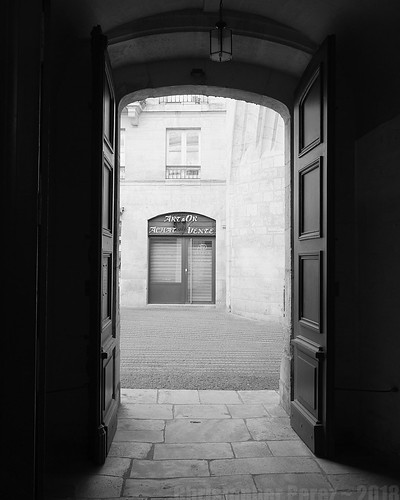I'm rather excited now that I begin to understand what I'm looking at in digital black and white photography. Contrary to how I was trained, a good image may not about have pure black nor pure white. Rather, I'm beginning to see that a worthy goal is about making a pleasing arrangement of lights and darks.
A friend of mine has known this for years. When I look at his work I'm impressed by how his work "glows." The greys are beautifully arranged. I think of him working in what I'll call "quiet light."
Using the technique outlined in an earlier blog entry I set about to see what I could see from a few images from a recent trip to Bordeaux. In this church interior there is a lot of detail, particularly in the ceiling. It seems as if the yellow filter I applied made that portion of the scene really "pop". No dodging or burning actions were taken. No selective increases in contrast were made. All processing activity was global to the image. This image is the simple result of following the technique.
I feel the light ceiling over the grand musical instrument is a decent example of finding the right mix and fix for matching digital images to old well printed black and white film.

The next image is, for me, a example of how light and dark play well together. There is a lot of detail in the highlights. There is a lot of detail in the shadow areas, too. As with the prior image no dodging or burning actions were taken. The sensation of contrasting light and dark is well preserved nearly straight out of the camera. To me this feels like a period silver halide image.

A friend of mine has known this for years. When I look at his work I'm impressed by how his work "glows." The greys are beautifully arranged. I think of him working in what I'll call "quiet light."
Using the technique outlined in an earlier blog entry I set about to see what I could see from a few images from a recent trip to Bordeaux. In this church interior there is a lot of detail, particularly in the ceiling. It seems as if the yellow filter I applied made that portion of the scene really "pop". No dodging or burning actions were taken. No selective increases in contrast were made. All processing activity was global to the image. This image is the simple result of following the technique.
I feel the light ceiling over the grand musical instrument is a decent example of finding the right mix and fix for matching digital images to old well printed black and white film.

The next image is, for me, a example of how light and dark play well together. There is a lot of detail in the highlights. There is a lot of detail in the shadow areas, too. As with the prior image no dodging or burning actions were taken. The sensation of contrasting light and dark is well preserved nearly straight out of the camera. To me this feels like a period silver halide image.

No comments:
Post a Comment